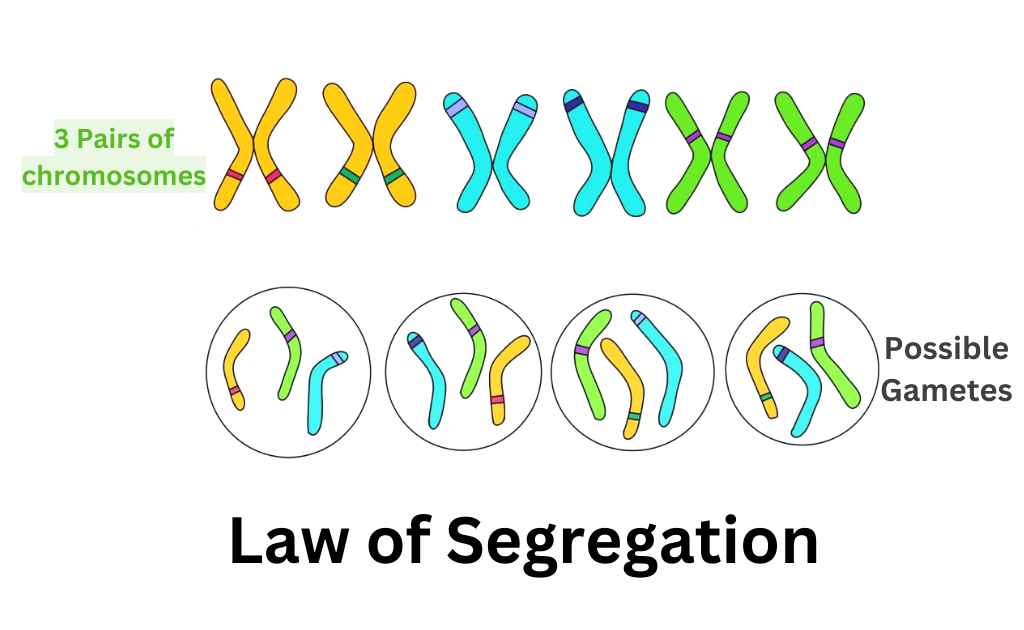Law of Segregation and Dominance is a fundamental concept in the field of genetics that explains the inheritance of traits from one generation to another. It is also known as Mendel’s Law of Segregation and is one of the key laws proposed by Gregor Johann Mendel, an Austrian monk and scientist, in the 19th century. This law describes how genes are passed on from parents to offspring and how certain traits are expressed.
An Introduction to Law Of Segregation And Dominance
The Law of Segregation and Dominance is based on the idea that every individual has two copies of each gene, known as alleles. During the formation of reproductive cells, these alleles segregate and only one allele is passed on to each offspring. This process ensures genetic variation and the inheritance of specific traits.
What is the Law Of Segregation?
The Law of Segregation states that during the formation of gametes (reproductive cells), the two alleles for a trait separate or segregate from each other. As a result, each gamete carries only one allele for a particular trait. When these gametes combine during fertilization, the offspring inherits one allele from each parent.
This law can be explained by the example of flower color in pea plants. If a pea plant has one allele for purple flower color (dominant allele) and one allele for white flower color (recessive allele), the offspring will inherit one of these alleles from each parent. As a result, the flower color of the offspring will depend on whether the dominant or recessive allele is present.

What is the Law Of Dominance?
The Law of Dominance states that when two different alleles for a trait are inherited, only the dominant allele will be expressed in the phenotype of the offspring. The recessive allele, on the other hand, will be masked and not expressed.
In the example of flower color in pea plants, the allele for purple flower color is dominant, while the allele for white flower color is recessive. Therefore, if a pea plant has one dominant allele and one recessive allele for flower color, the dominant allele will determine the flower color of the offspring.

Laws of Inheritance
The Law of Segregation and Dominance is one of three laws proposed by Mendel to explain the inheritance of traits. The other two laws are the Law of Independent Assortment and the Law of Dominance.
The Law of Independent Assortment states that the alleles for different traits segregate independently of each other during the formation of gametes. This means that the inheritance of one trait does not affect the inheritance of another trait.
The Law of Dominance and Uniformity states that when two homozygous individuals with different characteristics are crossed, the characteristics that appear in the first generation hybrid are dominant, while those that do not appear are recessive. This law explains why some traits are dominant and others are recessive.
Mendel’s Law
Gregor Johann Mendel, an Austrian monk and scientist, is often referred to as the father of modern genetics. Mendel conducted his experiments on pea plants and discovered the basic laws of genetics by cross-breeding different varieties of pea plants and analyzing the traits of their offspring. His experiments provided evidence for the existence of discrete hereditary units, which he called factors (now known as genes), and the principles of segregation and dominance.
Related Topic: Incomplete Dominance & Mendel’s Experiment
Who is Gregor Johann Mendel?
Gregor Johann Mendel was born on July 20, 1822, in Hyncice, Austria (now Czech Republic). He entered the Augustinian Monastery of St. Thomas in Brno, Czech Republic, in 1843 and took the name Gregor. Mendel’s interest in science and nature led him to study the inheritance of traits in plants, particularly pea plants.
Mendel conducted his experiments on pea plants in the monastery’s garden between 1856 and 1863. He cross-bred different varieties of pea plants and carefully observed the traits of their offspring. Through his experiments, Mendel discovered the principles of inheritance and developed his laws of segregation and dominance.

Mendel’s Experiment
Mendel’s experiments involved cross-breeding pea plants with different traits, such as flower color (purple or white), seed color (yellow or green), and seed shape (round or wrinkled). He carefully controlled the pollination process to ensure accurate results.
Mendel first performed what is known as a monohybrid cross, where he crossed two pea plants that differed in only one trait. For example, he crossed a purple-flowered pea plant with a white-flowered pea plant. He then observed the traits of the offspring, known as the first filial generation (F1 generation).
The Results of Mendel’s Experiment
Mendel’s experiments with pea plants yielded consistent and predictable results. In the case of the monohybrid cross between purple-flowered and white-flowered plants, Mendel found that all the offspring in the F1 generation had purple flowers. The white flower trait seemed to disappear.
However, when Mendel self-fertilized the F1 generation plants and observed the traits of the second filial generation (F2 generation), he found that the white flower trait reappeared. Approximately three-fourths of the F2 generation plants had purple flowers, while one-fourth had white flowers.
These results led Mendel to propose the Law of Segregation and the Law of Dominance. He concluded that the purple flower trait was dominant and the white flower trait was recessive. The dominant trait masked the expression of the recessive trait in the F1 generation, but the recessive trait reappeared in the F2 generation.
The Rediscovery of Mendel’s Theory
Mendel’s work went largely unnoticed during his lifetime, and his papers on inheritance were published in an obscure scientific journal. It wasn’t until the early 20th century that his work was rediscovered by three European scientists: Hugo de Vries, Carl Correns, and Erich von Tschermak.
The rediscovery of Mendel’s theories brought his work to the forefront of modern biology and genetics. His principles of inheritance provided a foundation for understanding the mechanisms of genetic inheritance, and his experiments laid the groundwork for future research in genetics.
Critical Appreciation or Importance of Law of Dominance
The Law of Dominance is a fundamental concept in genetics that helps explain how traits are expressed in offspring. It provides insights into the inheritance patterns of dominant and recessive traits and lays the foundation for understanding the genetic basis of various traits and diseases.
Understanding the Law of Dominance is crucial in fields such as agriculture, medicine, and evolutionary biology. It allows scientists to predict the probability of certain traits appearing in offspring and provides a basis for selective breeding programs to enhance desired traits in crops and livestock.
General Mendelian Deviation
While Mendel’s experiments and principles of inheritance laid the foundation for modern genetics, there are cases where the observed inheritance patterns deviate from Mendelian principles. Two common deviations are incomplete dominance and codominance.
Incomplete Dominance
Incomplete dominance occurs when the heterozygous phenotype is an intermediate blend of the two homozygous phenotypes. For example, in snapdragons, a cross between a red-flowered plant and a white-flowered plant produces offspring with pink flowers.
Codominance
Codominance occurs when both alleles for a trait are expressed equally in the heterozygous phenotype. An example of codominance is the blood type AB, where both A and B antigens are present on the surface of red blood cells.
These deviations from Mendelian inheritance patterns highlight the complexity of genetics and the influence of multiple alleles and gene interactions on trait expression.
Pairs of Unit Factors, or Genes
Mendel proposed that each trait is determined by a pair of unit factors, or genes. These genes exist in different forms called alleles, which can be dominant or recessive. The presence of a dominant allele determines the expression of a trait, while the presence of a recessive allele is masked by the dominant allele.
The concept of genes and alleles provides a framework for understanding the inheritance of traits and the variation observed within populations.
Alleles Can Be Dominant or Recessive
In Mendelian genetics, alleles can be dominant or recessive. A dominant allele is expressed in the phenotype even if only one copy is present, while a recessive allele is only expressed if two copies are present.
The dominance of an allele is not an inherent property of the allele itself but rather depends on its interaction with other alleles. Dominant alleles often code for functional proteins or enzymes, while recessive alleles may code for non-functional or non-essential proteins.
Equal Segregation of Alleles
According to Mendel’s Law of Segregation, during the formation of gametes, the two alleles for a trait segregate or separate from each other. This ensures that each gamete carries only one allele for a particular trait.
The equal segregation of alleles during gamete formation contributes to genetic variation in offspring and allows for the inheritance of specific traits from parents to offspring.
Independent Assortment
The Law of Independent Assortment states that the alleles for different traits segregate independently of each other during the formation of gametes. This means that the inheritance of one trait does not affect the inheritance of another trait.
The independent assortment of alleles during gamete formation contributes to the diversity of traits observed in offspring and allows for the combination of different genetic traits from both parents.
What is a Monohybrid Cross?
A monohybrid cross is a genetic cross between two individuals that differ in only one trait. This type of cross allows scientists to study the inheritance patterns of a specific trait and determine the genotype and phenotype ratios of the offspring.
Mendel’s experiments with pea plants involved monohybrid crosses, where he crossed plants that differed in one trait, such as flower color or seed shape. These crosses provided valuable insights into the principles of inheritance and the segregation and dominance of alleles.
Solved Examples on Law Of Segregation And Dominance
Example 1: In a monohybrid cross between a plant with purple flowers (PP) and a plant with white flowers (pp), what will be the phenotype of the F1 generation?
Solution: In this case, the dominant allele for purple flower color (P) will mask the expression of the recessive allele for white flower color (p). Therefore, all the plants in the F1 generation will have purple flowers.
Example 2: In a monohybrid cross between a heterozygous plant with yellow seeds (Yy) and a plant with green seeds (yy), what will be the phenotype ratio of the F2 generation?
Solution: In this case, the dominant allele for yellow seed color (Y) will be expressed in the heterozygous plants (Yy), while the recessive allele for green seed color (y) will not be expressed. The phenotype ratio of the F2 generation will be 3:1, with three plants having yellow seeds and one plant having green seeds.
How Kunduz Can Help You Learn Law Of Segregation And Dominance?
Kunduz is an online learning platform that provides comprehensive courses and study materials on various subjects, including genetics and the laws of inheritance. Kunduz can help you understand the Law of Segregation and Dominance and its applications in genetics.
Whether you are a student preparing for exams or a lifelong learner interested in genetics, Kunduz can help you master the concepts of Law of Segregation and Dominance and excel in your studies.
